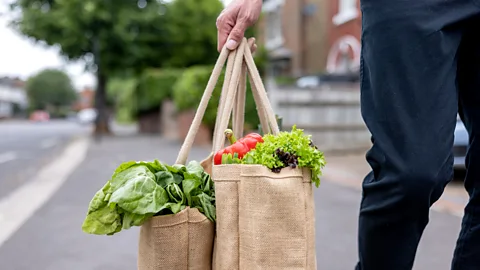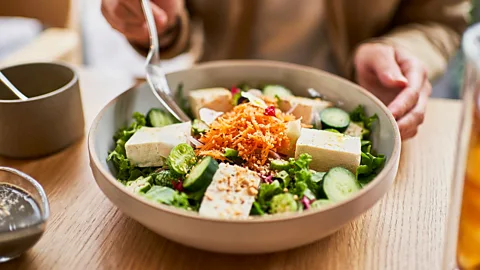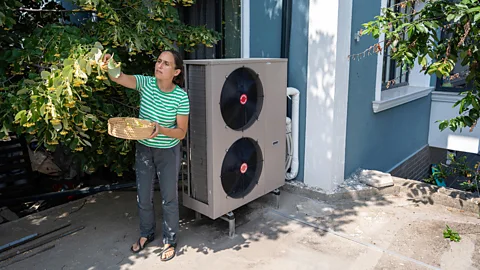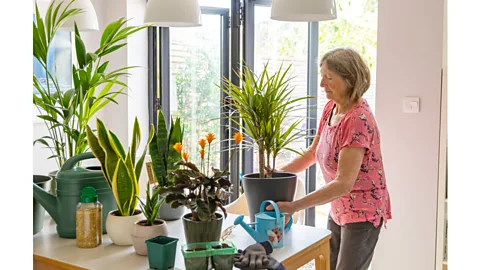By Isabelle Gerretsen, Zaria Gorvett, Martha Henriques, Katherine Latham, Lucy Sherriff and Jocelyn Timperley: BBC

Slowing down climate change is an immense task, but small individual actions can add up to help reduce emissions.
In 2024, the critical 1.5C threshold was breached for a full year for the first time, highlighting the urgent need to rapidly cut global emissions. Much of the work needed to curb climate change goes beyond the remit of individuals – from scaling up renewable energy to stopping the production of oil, gas and coal. But research shows that individual actions can add up too.
But it can sometimes feel overwhelming to know where to start. Which steps can actually make a meaningful difference? We have rounded up some of the most impactful actions you can take to live a more sustainable life this year, from eating more plant-based food to reducing your number of flights to buying more second-hand clothes.
Eat a plant-based diet
By 2033, it’s thought that there will be almost two billion cattle, one billion pigs, 32 billion poultry, and nearly three billion sheep on our small blue-green planet – that’s some 38 billion individual animals. As they go about their lives, all will be releasing the potent greenhouse gases methane and nitrous oxide – molecules which have effects 28 and 265 times stronger at warming the planet than carbon dioxide, respectively. That’s not to mention the vast amounts of land and water required to keep them.
As a result, it’s widely agreed among the scientific community that to rescue the global climate from ever-warming temperatures, one of the most impactful ways our species can change its behaviour is to eat less meat. According to one UK study, vegans have diets that emit just 25% of the carbon emissions of the most carnivorous meat-eaters, while both vegetarians and vegans have significantly lower water use and cause less harm to biodiversity than omnivorous ones.

In 2022, BBC Earth features editor Martha Henriques and senior journalist Zaria Gorvett decided to put this to the test, and tracked the carbon emissions of their meals over the course of a week. They found that the vegan diet did indeed have lower emissions overall, though on some days of the week the vegetarian diet won. Surprisingly, the amount of food waste generated and the cooking methods used each day also had a sizeable impact.
Take the train instead of flying
Transport is the biggest source of emissions in the US, where it contributes almost a third of the total emissions, and makes up 16% of emissions globally. While infrastructure change is critical to helping people cut the emissions from transport, individual action can still can go a long way toward reducing this.
If you fly regularly, it’s probably making up a huge proportion of your carbon footprint, so cutting out any flight is one of the best ways to live more sustainably. Using the train, bus or even a car with more than one person is nearly always lower carbon per km or mile. And reducing flying will also likely mean you travel closer to home, reducing carbon even further.

3:58What if we all stopped flying tomorrow?
This year one of our writers, Matilda Welin, even tried replacing an airplane journey between London and Sweden with a long-distance bike ride. While it cost more and took far longer than the plane would have, she experienced an “unforgettable journey” and enjoyed seeing the world “at human speed”. She now feels prepared to do shorter long-distance bikes rides more often, replacing car and train rides.
If you use a car, choosing a small one which uses less petrol and takes less energy and materials to manufacture will cut down on emissions, while electric vehicles are also an overall net win for the climate compared with their fossil-fuel-powered counterparts. Whatever car you have, simply driving less can have a big impact – especially on shorter journeys which can be made by foot or bike instead, which is also beneficial for your health. Of course, where feasible, getting rid of your car altogether is a good way of cutting emissions.
Buy fewer clothes
Fashion is a major contributor to global warming, responsible for 8-10% of global emissions, more than aviation and shipping combined. Every second, the equivalent of a rubbish truck full of clothes is burned or buried in landfill, according to the Ellen MacArthur Foundation, an environmental non-profit.
So how can you make your wardrobe more sustainable? The best thing you can do is to buy fewer new garments, especially fast fashion items which are often made from unsustainable materials.
Instead, you could rent clothes, upcycle your existing wardrobe or switch to second-hand clothes in thrift stores or through online platforms such as Vinted, Depop or eBay. Currently second-hand or upcycled clothing makes up just 9% of the average wardrobe in the US, but it is growing faster than any other channel in the US fashion sector and is expected to be a nearly $90bn (£73bn) market in the next 10 years.
Washing your clothes less frequently can also help reduce your wardrobe’s carbon footprint, by lowering energy usage, as well as prevent harmful microplastics from entering waterways.
It’s also important to think about what to do with your clothes at the end of their life. It is difficult to fully recycle clothes – just 1% of recycled items are turned back into new garments – but you could donate them, sell them, pass them onto friends or turn them into a craft project. Items thrown in the bin may go to landfill or be incinerated, resulting in more greenhouse gas emissions.

Reduce your carbon paw print
We love our pets. But research shows keeping animals is not always the most environmentally friendly thing to do. Take pet cats. They can generate over three tonnes of CO2 over the course of their life – equivalent to driving a petrol car 12,070km (7,500 miles).
Luckily, there are ways to reduce our animals’ carbon paw print. One option is to switch to more sustainable protein for their feed. The production of fish, for example, results in just a quarter of the emissions associated with lamb and beef. Another alternative protein gaining popularity in pet food is insects – which can be fed on food waste, and have a high feed-to-meat conversion rate.
A simple – but perhaps surprising – way to make your beloved pooch more sustainable is to switch to recycled dog poo bags, as opposed to bags made from virgin plastic or compostable alternatives, which have a surprising climate impact.
Consider heating alternatives
Keeping our buildings warm through winter is one of the biggest challenges in sustainable energy. Fossil fuels still meet 60% of the world’s energy demand for heating, and emissions from the sector are still growing despite a rise in renewable heat.
If we’re going to switch off our gas boilers – or at least turn the thermostat down for now, what can replace this source of heat to keep homes safely warm?
In Brussels, scientists and engineers have looked below the streets to its sewer system to heat the city’s buildings. A similar project in Vancouver, Canada is already helping warm homes in its False Creek suburb. Elsewhere, data centres and even the human body itself are other potential sources of heat that could be tapped to reduce the need for fossil-fuel-based heating.
Tapping that tantalising waste heat is often a district or city-wide project. But lower-carbon options are also emerging for individuals.

Heat pumps are now one of the most carbon-efficient ways to heat homes, alongside thermal energy from solar. Installation costs for heat pumps have seen a modest decline internationally, with costs predicted to decline a little further to 2030, according to one analysis. They are still however an expensive upfront cost, though there are financial incentives for heat pumps in 30 countries.
The International Energy Agency estimates that by 2030, heat pumps could reduce global CO2 emissions by at least 500 million tonnes, or the equivalent of the annual CO2 emissions of all cars in Europe today.
In the meantime, for those reliant on a gas boiler, basic fixes can help improve the efficiency of your heating and reduce energy bills – such as improved insulation, draught excluders and thick curtains.
Invest in a greener pension
When discussing sustainability, we don’t often think of our personal finances. But how we choose to save, invest and spend our money can make a surprisingly big difference to the climate.
Banks are major financiers of fossil fuels and while the money you put in the bank doesn’t directly go towards this, experts say that it can make a difference to their social licence. If you are unhappy with your bank’s current policies, you could consider moving your money to a credit union or building society, which are less likely to be funding fossil fuels due to the way they invest.
Your pension is one of the most direct ways in which you can make your spending greener. Pension funds are the largest investors in global capital markets, with total assets over $56tn (£44.5tn), making your pension an incredibly powerful tool. Despite this, most people don’t even know how their pension is invested. A good first step is to ask your pension provider what they are investing in about their sustainability policies and options.

Cut down on single-use plastic
Plastic has seeped into every aspect of our existence. Microplastics have been found in Antarctic sea ice, inside animals in the deepest ocean trenches and in our food and drinking water.
Plastic production is expected to at least double by 2050, while plastic waste in the US has grown continuously since 1960. If we continue our plastic consumption at the current rate, it could account for 20% of oil production by 2050. More than 99% of plastic is made from chemicals sourced from fossil fuels.
It is difficult to completely cut out plastic, but we can take steps to reduce our consumption. This could not only help the planet, but our health too, as some types of plastic have been linked to infertility and endocrine problems.
Buying loose vegetables is a great way to help rid your weekly shop of plastic, but often you still need to bag them in store – and the bags available are often plastic. The solution? Bring your own muslin reusable produce bag.
Perhaps also have a think about where you buy your milk. Milk vending machines are popping up on farms all over the UK and the trend is beginning to catch on in North America too. You bring your own glass bottles (or buy one there), and fill up with fresh milk – eliminating the need for plastic packaging.
You could also start shopping at a zero-waste store, where you can refill your bathroom and plastic-free cleaning products. Once you’ve got a tin (either buy one from the store or reuse a biscuit tin), a soap dispenser, and a spray bottle, you just reorder the products as and when you need them, and they’re shipped in paper packaging.
Swap cling film for beeswax wrapping. Available in fancy patterns or just plain, they’re forever reusable as they can be easily rewaxed with beeswax once it wears off.
Plastic utensils are hard to recycle (at least in the US). So think twice about whether you really need them, or carry around a portable utensil kit, which usually come in neat carry cases. This applies to straws too. Paper straws aren’t necessarily better for the environment, so you could include a reusable straw in your kit too.




